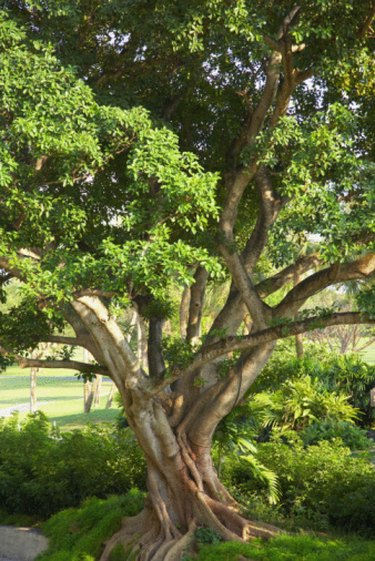
The common fig tree (Ficus carica) grows in warm and temperate regions. Growers in southern states such as South Carolina and Florida cultivate the tree for its fruit, which can be eaten raw, preserved or used in baking projects. The medium-sized tree reaches heights of 30 feet and possesses a very large root system that can cover 50 feet. As with most species of trees, figs suffer infestation from certain insect species. Using insecticidal bug sprays may help relieve such problems.
Fig Pest Problems
Video of the Day
Fig trees suffer from various pest problems. Nematodes commonly attack fig-tree roots to the extent that growers in the tropics plant figs next to walls and buildings so the roots of the tree can escape nematode infestation by growing beneath the abutting structure. Stem and fig borers destroy wood on trees and lay larvae that bore into plant material. Scale insects affect fig trees by removing important liquids such as glucose with their sucking mouthparts. In Florida, the fig whitefly regularly attacks fig trees and causes extensive damage.
Video of the Day
Managing Pests Using Bug Sprays
A number of chemical substances, including pesticides, insecticides and natural oils, exist for managing pests of fig trees. These bug sprays help minimize pest population and must always be used exactly as instructed. University of Minnesota horticulturalists recommend managing scale insects with paraffinic oil, insecticidal soap, chlorpyrifos, carbaryl, acephate and malathion. Few chemical controls prove effective on borer insects, and most products put on the market for such purposes prove ineffective. Manufacturers withdraw many such insecticides due to ineffectiveness. Methyl bromide and chloropicrin manage nematode populations, though both prove very strong and dangerous and must only be used with extreme caution.
Fig Whitefly Bug Sprays
A team of University of Florida horticulturalists recommends an extensive list of chemical controls for fig whitefly management. Applied to soil surrounding a tree, imidacloprid insecticides and dinotefuran insecticides manage fig whitefly without damaging natural predators. Bifenthrin, cyfluthrin and carbaryl insecticides prove effective against fig whitefly, though they may kill natural predators of the species. Also use imidacloprid, pyriproxyfen, pymentrozine, spiromesifen, buprofenzin and acetamiprid when managing fig whitefly.
Finding Sprays and Major Infestations
Always identify the insect population in a fig tree before purchasing a bug spray. Contact a local university horticultural or entomology department, or a garden-supply store or nursery, with assistance in identifying insect infestation. Ask for recommended bug sprays.
Managing major infestations in medium or large trees such as fig with bug sprays proves unrealistic. The amount of insecticide required to manage a major infestation on a fig tree may break local laws, prove incredibly destructive to the local ecosystem and harm humans and other large animals in the area, not to mention potentially killing the infested plant.
Integrated Pest Management
Expert resources from the University of California Integrated Pest Management Program to extension departments with the University of Florida, Clemson University and the University of Minnesota recommend an integrated approach to managing pests in plants. Never rely solely on chemical controls. When managing bugs in fig trees, try methods such as replanting, proper mulching and fertilization and the introduction of natural predators. Maintaining a healthy plant helps prevent pest and diseases infestation.
- Purdue University Horticulture; Fig; Julia F Morton; 1987
- University of Florida IFAS Extension; The Fig Whitefly; Catherine Mannion, et al.
- Clemson Cooperative Extension; Figs; David Parker, et al.; 1999
- University of Florida IFAS Extension; Fig Plant Disease Management Guide; Aaron J. Palmateer, et al.
- University of Florida IFAS Extension; Borer Insects; Daniel L Frank, et al.